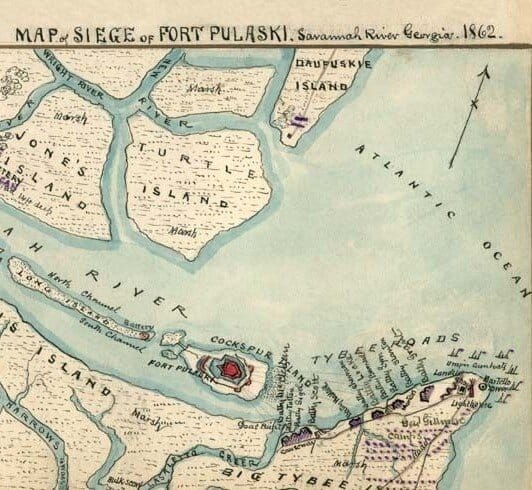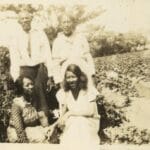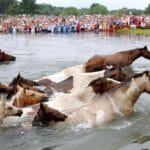Picture this: Daufuskie Island, a mesmerizing time capsule nestled off the South Carolina coast. Here, history and nature entwine, painting a vivid tapestry of resilience, cultural diversity, and the enduring spirit of its people. Join us as we embark on an adventure through time, uncovering the hidden gems of this enchanting island and connecting the threads of its past with the present.
History of Daufuskie Island
Daufuskie Island whispers tales dating back millennia. Imagine Native American tribes, the Muscogee people, navigating the surrounding waters as early as 9,000 years ago, their presence evidenced by unearthed tools, pottery shards, and the evocative mounds of oyster shells – silent echoes of their existence. It was they who bestowed upon the island its unique name, “Daufuskie,” meaning “sharp feather,” an apt tribute to its distinctive shape.
As centuries passed, Daufuskie found itself interwoven with pivotal moments in American history. During the Revolutionary War, a significant number of islanders pledged allegiance to the British Crown. Later, the shadows of the Civil War stretched across its shores, transforming the island into a microcosm of the era’s conflicts. Plantations, symbolic of the South’s agrarian economy, dotted the landscape, while the resilience of freed slaves unfolded against a backdrop of Union occupation.
Yet, perhaps the most enduring legacy of Daufuskie Island lies in the vibrant tapestry of its Gullah culture. Descended from enslaved Africans, the Gullah people have steadfastly held onto their ancestral traditions, their unique language, and their distinct way of life. Their heritage infuses the very essence of Daufuskie – a symphony of music, captivating stories, and an unyielding spirit of resilience that continues to captivate and inspire.
Let’s delve deeper into the captivating layers of Daufuskie’s past:
Native American Origins
- While we can’t turn back the hands of time, archaeological evidence strongly suggests a continuous Native American presence on Daufuskie Island for nearly 9,000 years. Artifacts and those intriguing oyster shell mounds provide valuable clues for archaeologists, piecing together the daily lives of these early inhabitants.
- The name “Daufuskie” itself stands as a testament to the Muscogee people’s profound connection to nature and their keen observation of their surroundings. To them, the island’s outline resembled a “sharp feather.”
Historical Footprints
- Daufuskie Island wasn’t merely a passive bystander to history; it played an active role. During the tumultuous years of the Revolutionary War, a number of islanders made the difficult choice to side with the British, adding another layer of complexity to the island’s narrative.
- The Civil War left an indelible mark on Daufuskie. Plantations, once symbols of power and wealth, underwent profound transformations, their fates intertwined with those of the newly freed slaves. The arrival of Union soldiers transformed Daufuskie into a place of transition and, for many, a sanctuary from the turmoil engulfing the nation.
The Enduring Spirit of Gullah Culture
- Imagine a culture so deeply rooted, so vibrant, that it has not only survived but thrived through centuries of change – this is the legacy of the Gullah people on Daufuskie Island. They carried with them the traditions, beliefs, and stories of their African homeland, skillfully weaving them into the fabric of their new world.
- To this day, the Gullah community on Daufuskie continues to speak their distinct dialect – a beautiful fusion of languages – and their cultural heritage shines through in their music, captivating storytelling, and intricate crafts. Their story serves as a powerful testament to the indomitable nature of the human spirit and the crucial importance of preserving cultural identity.
Why is Daufuskie Island Abandoned?
The air of mystery surrounding Daufuskie Island often leads to the question: why does it feel deserted? The truth is, Daufuskie hasn’t always been this way. Its story is one of cycles – periods of prosperity interspersed with challenges. To truly understand its present state requires a journey back in time.
Imagine Daufuskie Island as a bustling vacation destination, its shores teeming with life. Now, picture it dotted with vacant buildings and silent houses. The stark contrast begs an explanation. A significant chapter in Daufuskie’s story revolves around the Melrose Resort, a luxurious destination that once drew visitors from far and wide. However, financial turmoil and the looming threat of hurricanes forced its closure in 2001.
The Melrose Resort, in many ways, acted as the island’s economic engine. Its closure sent ripples throughout the community, impacting businesses and residents alike. Tourism, the lifeblood of Daufuskie’s economy, dwindled, leaving many businesses struggling to survive. The island’s small size and limited industries offered little in the way of alternative economic lifelines.
The Gullah people, deeply connected to Daufuskie for generations, felt the impact acutely. As the island’s economic heart slowed, many were compelled to seek opportunities elsewhere. Their unique blend of African and American traditions, so much a part of Daufuskie’s identity, began to fade from the island, contributing to the sense of emptiness that pervades today.
Daufuskie’s population now stands as a fraction of what it once was. The island serves as a poignant reminder that even in places renowned for their beauty and tranquility, the winds of change can bring about profound transformations.
Daufuskie’s story unfolds like a complex puzzle, its pieces scattered across time – Native American settlements, the enduring legacy of Gullah traditions, echoes of the Civil War, and the ebb and flow of tourism. Each piece contributes to our understanding of why this captivating island, while exuding an aura of haunting silence, continues to beckon travelers with its enigmatic charm.
It’s crucial to remember that Daufuskie’s current state is the result of a complex interplay of factors. There’s no single explanation that encompasses the entirety of its narrative. Researchers are diligently working to piece together the intricate tapestry of the island’s past, and their understanding of what ultimately led to its decline might very well evolve as they uncover new insights.
Despite the challenges, Daufuskie Island remains an alluring destination. Its deserted landscapes whisper tales of bygone eras, inviting visitors to contemplate the relentless passage of time and the delicate balance between progress and preservation.
Who Famous Lives on Daufuskie Island?
Daufuskie Island’s allure has attracted its fair share of notable figures over the years, individuals whose lives have become intricately woven into the island’s fabric.
No discussion of Daufuskie would be complete without mentioning Pat Conroy, the celebrated author who found solace and inspiration amidst its serene beauty. His bestselling novel, “The Water is Wide,” not only captivated readers but also shone a spotlight on Daufuskie for a wider audience. Conroy’s connection to the island ran deep; he held a genuine affection for its people and its unique character, often featuring them in his literary works.
Another luminous figure connected to Daufuskie is Sallie Ann Robinson, a true island treasure. With family roots on Daufuskie stretching back generations, she’s more than just a renowned chef and cookbook author; she’s a guardian of Gullah traditions, ensuring that the customs and stories passed down through Daufuskie’s African American community continue to thrive. Sallie Ann stands as a living embodiment of the island’s history, her life a testament to the resilience and spirit of the Gullah people.
Beyond the realm of global recognition, Daufuskie boasts its own local legends, individuals who may not have graced the covers of magazines but whose contributions to the island are no less significant.
| Daufuskie Figure | Known For | Why It Matters |
|---|---|---|
| “Cuffy” Jones | Island Historian, Storyteller | Played a vital role in preserving Daufuskie’s rich oral history. |
| The Bailey Family | Generations of Artisans (Sweetgrass) | Their craftsmanship has ensured the survival of traditional Gullah crafts, keeping this vital aspect of the island’s cultural heritage alive. |
| Ms. Emily | Longest-residing resident (at one point) | Represented a living link to Daufuskie’s past, embodying the island’s enduring spirit. |
It’s worth noting that our knowledge of Daufuskie’s past residents is an ongoing process of discovery. Historians continue to unearth new information, shedding light on the lives of those who have called the island home and their unique contributions to its tapestry.
Daufuskie Island’s story, however, isn’t just about the famous names etched in history books. It’s about the everyday heroes – the families who have fished its waters for generations, the artisans keeping traditions alive, and the individuals who embody the true spirit of the island. Their names may not be widely known, but their lives are what make Daufuskie genuinely special.
Who were the Indians on Daufuskie Island?
Long before European settlers set foot on Daufuskie Island, it was home to thriving Native American communities. Archaeological evidence suggests that humans may have inhabited the island as far back as 9,000 BCE. However, the first well-documented inhabitants were the Creek Indians, more formally known as the Muscogee people. They lived in harmony with the land, relying on its bounty for sustenance. Daufuskie, with its fertile soil and abundant waterways, provided ample resources for the Creek people to thrive. They were skilled fishermen, harvesting the bounty of the surrounding waters, and adept cultivators, ensuring their sustenance from the land itself. Their lives were deeply intertwined with the natural world, reflecting a profound understanding and respect for the delicate balance of nature.
As word of this idyllic island paradise spread, European explorers and traders began to arrive in the 16th century, forever altering the course of Daufuskie’s history. The Spanish were among the first to lay claim to the Atlantic coast, including Daufuskie, viewing it as territory ripe for exploitation. Approximately a century later, British colonists arrived, driven by similar ambitions of expansion and dominion over the land.
Sadly, the arrival of European settlers marked a turning point for the Creek Indians. The encounter between these vastly different cultures led to conflict and displacement, forever changing the face of Daufuskie Island.
Do Gullah people still live on Daufuskie Island?
Daufuskie Island’s intricate past has been shaped by a diverse array of people, with the Gullah people, descendants of enslaved Africans, playing a particularly significant role. For generations, they flourished on the island, their culture becoming an integral part of Daufuskie’s identity. However, the passage of time has brought about undeniable changes. Factors such as rising property values, increased development, and a shifting economic landscape have contributed to a decline in the Gullah population on the island.
So, do Gullah people still call Daufuskie Island home? The answer is yes, but their presence, while enduring, is smaller than in previous generations. It’s believed that only a handful of Gullah families remain on the island, clinging steadfastly to their deep-rooted heritage. Though their numbers may have diminished, their impact on Daufuskie’s cultural fabric remains vibrant and significant.
Think of Daufuskie’s story as a beautifully crafted quilt, passed down through generations. Each piece of fabric represents a chapter in the island’s history, and the Gullah story is woven deeply into its very essence. Even though some of the original threads may be fading with time, their pattern remains a vital part of the quilt’s beauty and historical significance.
One of the most passionate advocates for preserving Gullah heritage on Daufuskie Island is Chef Sallie Ann Robinson. As a sixth-generation native, she serves as a bridge between the past and present, sharing her extensive knowledge of Gullah traditions and stories through guided tours and immersive culinary experiences. Her efforts, along with those of others who cherish Daufuskie’s unique blend of cultures, aim to ensure that Gullah traditions and history are never forgotten, allowing future generations to appreciate the richness they bring to the island.
It’s essential to recognize that Daufuskie Island’s story, much like the story of the Gullah people, is still being written. What the next chapter holds remains to be seen. However, by understanding the challenges faced by the Gullah community, celebrating their strength and resilience, and actively supporting their cultural preservation efforts, we can help ensure that their legacy continues to shine brightly on Daufuskie Island for generations to come.
Want to explore other facets of history and culture? Immerse yourself in these captivating stories:
- Unravel the threads of time with the history of crochet from 1500 BC to 1820, discovering the intricate techniques that have adorned garments for centuries.
- Journey back to the origins of Easter celebrations and witness the evolution of the history of Easter bonnets, a delightful fashion statement that has graced heads during this festive spring holiday.
- Venture further south and delve into the captivating history of Edisto Island, SC, where tales of pirates, sprawling plantations, and the vibrant tapestry of Lowcountry culture intertwine.
- Unveiling the Enigma: Mansoureh Khojasteh Bagherzadeh’s Public Appearances & Private Life in Iran - July 18, 2025
- Unveiling the Mystery: Mansoureh Khojasteh Bagherzadeh’s Husband: A Rare Glimpse into a Private Life - July 18, 2025
- Unveiling Masoud Khamenei’s Mother: Power, Influence, and Iran’s Future - July 18, 2025
















